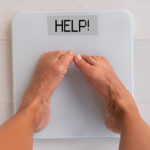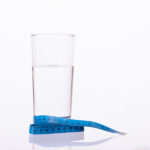By David Blyweiss, M.D., Advanced Natural Wellness
March 13, 2019
Overeating is built into our genes. It comes from the days when our ancestors experienced long periods of famine.
Once food became available again, they didn’t just take five bites of it and say “ Leftovers for lunch tomorrow! ”
No way.
They kept on eating… as much as they could for as long as they could. It was the only way they had to build up their energy stores to survive the next famine.
But today we don’t really have a feast and famine problem. You know that as well as I do.
If your stomach gives off even the slightest growl, the fridge is only 10 or 20 feet away. The kitchen cabinets are stocked. And there’s a Subway, Olive Garden or some other restaurant just down the street.
As a result, you could be eating a lot more calories than you should be. As a matter of fact, these days it’s estimated that the average American adult eats about 3,770 calories a day. That’s well above recommendations for both men and women.
MD Exposes the Hidden Danger to Your Eyes

When your eyesight starts to fail, it's a real problem. Suddenly you can't go to the grocery store... you can't get to the doctor if you have an emergency... you can't meet your friends for dinner…
Your "regular" doctor doesn't have time to keep up with the latest research. And the same goes for eye doctors. They go to school to learn how to fit you for glasses and contacts, but have no way of preventing the damage and loss of eyesight that threatens your freedom and independence.
Let me show you something that explains a LOT about how your eyes work.
In my FREE Special Report, I'll show you a HUGE, untapped resource for your eyes that safely and naturally restores clear, effortless eyesight.
Click here to get started...
However your body has no idea that it’s not going to enter a period of starvation in the next week or month. So it just keeps on being hungry and saving up all that energy – which eventually turns to fat – and has a lot to do with the obesity problem here in the U.S.
And I’ll be honest with you. It’s really easy to overeat without even realizing it.
Today’s portion sizes are HUGE. Back when I was growing up, I wasn’t allowed to leave the dinner table until my plate was empty. But in those days, a full plate consisted of about 5 ounces of meat, a big serving of some sort of starchy food, and a pile of soggy green or yellow/orange vegetables, sometimes out of a can…and I was grateful to have it. Dessert wasn’t an option. It was only served on special occasions.
These days it’s a whole ‘nother story. It’s not uncommon to see people in restaurants eating 16 ounce steaks with Texas-sized over-stuffed potatoes. (And that’s only what comes between the super-sized appetizers and overly sweetened desserts!)
Huge meals are what we’ve come to expect in the new millennium. But what they really are is a HUGE problem.
- If you usually eat everything on your plate without giving it a second thought, chances are good that you are struggling with your weight.
Today’s foods aren’t the same ones your ancestors ate. These days about 40% of the average adults’ daily calories come from inflammatory vegetable oils, such as soybean, corn or canola oil. Another 25% is from processed grains and flours. (This doesn’t even include all of the high fructose corn sweeteners that are in just about everything that comes in a can, jar or package.)
These are all high-density foods. Just small amounts of them contain a high number of calories. At the same time, they have hardly any nutritional value.
- Fried foods, processed grains and sugars all contribute to obesity and diabetes.
Junk food is ubiquitous in our society. I find that even my most committed patients often don’t realize how much “junk food” they consume. It just tends to sneak up on them… the cookies someone left in the break room at work, a pizza party for the kids or grandkids, burgers and fries in a pinch.
Maybe it’s a bag of chips, packaged meat products and soda while they’re on the road… or the donuts and bagels at some meeting.
- Energy dense foods like these don’t just fatten you up. They also compromise your health.
It can only benefit us to recognize that “ junk food” is a misnomer, there is food… and then there is junk.
Are You Suffering From...
- Love handles and a pot belly
- Romance that isn't what it used to
- Forgetfulness and inattention
- Low (or no) strength and endurance
- A sex drive that's shifted into neutral...or worse
If so...you may have Mature Male Burnout. Click here to discover more about this unique condition and what you can do about it.
It can only benefit us to recognize that “ junk food” is a misnomer, there is food… and then there is junk.
One way or another, it all adds up to too way many calories.
“How can I get rid of all those Extra Calories?”
My patients ask me this a lot. They’ve been eating too many calories for too long. And now they want to release all of that “stored energy” that, unfortunately, has turned to fat.
Exercise is the first step. It’s really the only way to burn those extra pounds from your body. I personally recommend high intensity interval training. I find that it’s the most effective way to promote weight loss and build strong, lean muscle.
If that’s not doable in your life, then an effective AND mellower way (and just as much fun) is the LISS program.
But it’s equally important to slash your caloric intake.
And when you understand that a chunk of your calories come from high density foods like fatty meats, fried foods, dairy products, desserts, processed foods and those that are high in sugar it’s hard not to do.
So look to replace them with lower density foods when you can; increasing the frequency, variety and amounts until it becomes a habit or a norm with you.
Fruits, vegetables, beans, soups, stews, lean meats and foods with a high fiber content are all considered low density. They provide a lot of nutrients, very few calories and often have a high water content.
And it’s real easy to add them to your meals.
- Add extra vegetables to your soups, stews and meals.
- Choose grilled or roasted meats and vegetables over those that are fried.
- Include more beans, peas and lentils in your meals. Serve them as a side or add them to your soups, chilies, stews and salads.
- Go easy on the sauces. If you load your foods up with buttery and creamy sauces, you’ll end up making them more energy dense. If sauce though helps you eat your vegetables then discover the online recipe world to find the tastiest healthiest ones…my most used are the Asian sauces.
- When it comes to creamy deserts, opt for making them with plain Greek yogurt or dairy free choices over other dairy products.
But when you do choose to eat high density foods, choose only the best of the best.
This includes foods like extra virgin olive oil, fatty fish, avocado, nuts and seeds that all have an important place in your diet. It’s also okay to enjoy reasonable portions of lean grassfed meat and pasture-raised poultry.
And don’t forget to watch your portion size and keep moving!
SOURCES:
Marteau TM, et al. Downsizing: policy options to reduce portion sizes to help tackle obesity. BMJ. 2015 Dec 2;351:h5863.
What’s on your table? How America’s diet has changed over the decades. Pew Research Center. Dec 2016.
FAO Statistics Division 2010, Food Balance Sheets, Food and Agriculture Organization of the United Nations, Rome, Italy, viewed 17th March, 2011.
Buckland NJ, et al. A Low Energy–Dense Diet in the Context of a Weight-Management Program Affects Appetite Control in Overweight and Obese Women. The Journal of Nutrition, Volume 148, Issue 5, 1 May 2018, Pages 798–806,
Stelmach-Mardas M, et al. Link between Food Energy Density and Body Weight Changes in Obese Adults. Nutrients. 2016 Apr; 8(4): 229.








